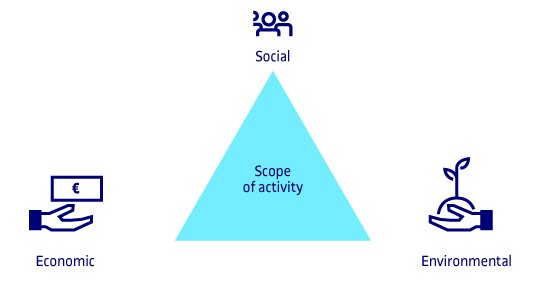2.3. Characteristics
2.3.1. Key scope areas
Depending on the typology and initial design configuration, complementary currencies can promote social, economic and environmental activity to a greater or lesser degree. They may therefore have a more or less holistic perspective, according to the degree of equilibrium between the three scope areas of activity.
Social activity
- For some authors, the principal objective of complementary currencies is to improve the social well-being of the communities in which they circulate. Community members receive psychological benefits such as recognition, sense of belonging and self-esteem through social interaction, as opposed to individualism and material consumerism. This can occur in various ways: for example, in acts of solidarity among neighbours which encourage a sense of community and the building of mutual trust. Initiatives like these encourage the participation of socially excluded groups and are especially useful in areas where communities have become fragmented and there is mistrust between social groups.
- Since everyone has something to offer, including skills with little value in the formal labour market, complementary currencies enable the empowerment of socially excluded groups, boosting self-esteem, trust, social participation and well-being. These aspects, even the small interactions involved in more economically-motivated transactions, add up to the growth of community spirit and friendship networks.
- Prosocial behaviour is a social behaviour whereby people voluntarily act for the benefit of others, usually without any benefit to themselves. Complementary monetary systems can give rise to prosocial behaviour inspired by the principles of altruism, solidarity and mutual assistance.
Economic activity
- Complementary currencies are cited by many organizations as an instrument to build local circuits of economic value that prevent wealth from flowing out of the community, have a multiplier effect on the local economy and promote the localization of processes.
- Informal work, skills exchanges, volunteering and domestic work, all crucial to market economy, can be effectively valued, recognized, compensated and even exchanged thanks to complementary currencies. All of this can help to counteract the exploitation of labour via formal employment and help to build economic relationships in which cooperation and exchange play a valuable part.
- Alternative currencies also provide a complementary medium of access to goods and services to people who are financially excluded or unable to find formal employment. In addition, complementary currencies can support sustainable economic development by providing small, local, community-loyal companies with mutual credit systems that enable them to trade with each other without the need for conventional money. Some of these currencies even specifically support social companies and businesses with a sustainability focus.
Environmental activity
- Complementary currencies have a positive environmental impact on the ecological footprint: more local consumer models are created to take the place of imports, thus reducing the amount of energy needed for transportation. They also facilitate the exchange of resources and provide a market for the sale of goods produced locally with local and even reused resources.
- Some complementary currencies stimulate more environmentally-friendly behaviour, for example, they can be used to incentivize citizens to take part in recycling programmes, purchase more sustainable products, or use public transport. Complementary currencies can also encourage the development of new green technologies such as renewable energies, increasing capital investment by issuing currency as a reward for energy production.
